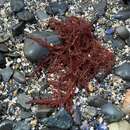en
names in breadcrumbs


Bonnemaisonia hamifera is a species of red alga in the family Bonnemaisoniaceae. Originally from the Pacific Ocean, it has been introduced into the northeastern Atlantic Ocean, where it is considered invasive on European coasts. It exists in two phases which, at one time, were thought to be different species; a medium-sized feathery form attached to other seaweeds, and a small tufted form known as Trailliella.
This algal species exists in two phases. The gametangial phase is always epiphytic, growing on Cystoseira and other algae. It forms erect, brownish-red, feathery fronds and grows to a length of up to 35 cm (14 in). The fronds are flattened and bear crozier-shaped hooks which cling on to and get tangled with the host seaweed. The tetrasporangial phase forms much-branched, brownish-red tufts of fine filaments growing in small clumps with a width of 2.5 cm (1 in) and resembling cotton wool.[3] They are epiphytic on coralline algae or occasionally grow direct on rock or other hard substrate.[4] The red colour of this species comes from the presence of the pigments phycoerythrin and phycocyanin which mask the chlorophyll a, beta-Carotene and various xanthophylls which are also present.[2]
B. hamifera is native to the northwestern Pacific Ocean and the coasts around Japan. It was introduced into the northeastern Atlantic Ocean in the late nineteenth century, possibly arriving on the hull of a ship or among shellfish. It is now present from Iceland and northern Norway southward to Portugal, as well as in the Canary Islands, Algeria, Tunisia and the Adriatic Sea. It was first noticed in Britain, on the coast of Dorset in 1890, when the form "Trailliella" was collected.[4] The first record in Ireland was in A. D. Cotton's 1915 survey of the marine algae of Clare Island, County Mayo.[5] The first record in Northern Ireland was in 1972 from Sandeel Bay.[6] It grows in the low intertidal zone and to depths of about 8 m (26 ft) and can be abundant in lagoon-like areas on the lower shore.[3]
This seaweed displays a complex life cycle with an alternation of generations between the gametophytes and the tetrasporophytes. In the spring, gametophytes occur. The sperm produced is not motile and relies on currents to bring it to the female reproductive structures. Fertilisation results in the production of carposporophytes, which in turn produce carpospores which develop into the original tetrasporophytes.[7] The tetrasporophyte occurs throughout the year, but is most common between October and March. It was at one time thought to be a different species and was given the name Trailliella intricata.[4] Vegetative reproduction is uncommon, but asexual reproduction occurs as a result of fragmentation of the thallus.[2]
Bonnemaisonia hamifera is a species of red alga in the family Bonnemaisoniaceae. Originally from the Pacific Ocean, it has been introduced into the northeastern Atlantic Ocean, where it is considered invasive on European coasts. It exists in two phases which, at one time, were thought to be different species; a medium-sized feathery form attached to other seaweeds, and a small tufted form known as Trailliella.
Bonnemaisonia hamifera est une espèce d'algues rouges de la famille des Bonnemaisoniaceae. Originaire de l'océan Pacifique, elle a été introduite dans le nord-est de l'océan Atlantique où elle est considérée comme envahissante sur les côtes européennes. Elle existe en deux phases qui, à un moment donné, étaient considérées comme des espèces différentes : une forme plumeuse de taille moyenne attachée à d'autres algues et une petite forme touffue connue sous le nom de Trailliella.
Cette espèce d'algue existe en deux phases. La phase gamétangiale est toujours épiphyte, se développant sur Cystoseira et d'autres algues. Elle forme des frondes plumeuses dressées rouge brunâtre et peut atteindre une longueur de 35 cm. Les frondes sont aplaties et portent des crochets en forme de crosse qui s'accrochent et s'emmêlent avec l'algue hôte. La phase tétrasporangiale forme des touffes rouge brunâtre très ramifiées de fins filaments poussant en petites touffes d'une largeur de 2,5 cm et ressemblant à du coton[1]. Elles sont épiphytes sur les algues corallines ou poussent parfois directement sur la roche ou un autre substrat dur[2]. La couleur rouge de cette espèce provient de la présence des pigments phycoérythrine et phycocyanine qui masquent la chlorophylle a, le bêta-carotène et diverses xanthophylles également présentes[3].
B. hamifera est originaire du nord-ouest de l'océan Pacifique et des côtes du Japon. Elle a été introduite dans le nord-est de l'océan Atlantique à la fin du XIXe siècle, arrivant peut-être sur la coque d'un navire ou parmi les coquillages. Elle est maintenant présente depuis l'Islande et le nord de la Norvège jusqu'au Portugal, ainsi qu'aux îles Canaries, en Algérie, en Tunisie et dans la mer Adriatique. Elle a été remarqué pour la première fois en Grande-Bretagne, sur la côte du Dorset en 1890, lorsque la formeTrailliella a été collectée[2]. Le premier enregistrement en Irlande a été réalisé en 1915 par A. D. Cotton sur les algues marines de l'île de Clare, dans le comté de Mayo[4]. Le premier enregistrement en Irlande du Nord remonte à 1972 à Sandeel Bay[5]. Elle pousse dans la zone intertidale basse et à des profondeurs d'environ 8 m et peut être abondante dans les zones de type lagon sur la rive inférieure[3].
Le nom scientifique complet (avec auteur) de ce taxon est Bonnemaisonia hamifera Hariot[6].
Bonnemaisonia hamifera a pour synonymes[6] :
Bonnemaisonia hamifera est une espèce d'algues rouges de la famille des Bonnemaisoniaceae. Originaire de l'océan Pacifique, elle a été introduite dans le nord-est de l'océan Atlantique où elle est considérée comme envahissante sur les côtes européennes. Elle existe en deux phases qui, à un moment donné, étaient considérées comme des espèces différentes : une forme plumeuse de taille moyenne attachée à d'autres algues et une petite forme touffue connue sous le nom de Trailliella.